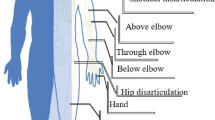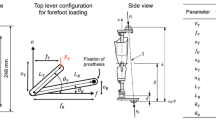Abstract
The loss of a lower limb has a profound impact on an individual’s mobility, necessitating the development of prosthetic feet as a restorative solution. However, the production of prosthetic feet for end-users faces challenges due to the diverse array of process variables, and materials involved. This study aims to investigate the effects of process variables, namely nozzle hole diameter (0.15mm, 0.25mm, 0.40mm) and internal filling pattern (grid, honeycomb, and tri-hexagon), on the compression behaviour of three composite materials: poly lactic acid reinforced with carbon fibre, polyethylene terephthalate glycol reinforced with carbon fibre, and poly lactic acid reinforced with multi-walled carbon nanotubes. These components are fabricated using fused filament fabrication. The manufactured samples were subjected to compression testing, followed by a thorough analysis of failure morphology. Statistical analysis, specifically Taguchi's methodology and response surface methodology, are employed to assess how compression behaviour varies with the specified process variable. The study’s findings are leveraged to develop a foot prosthesis through fused filament fabrication, emphasizing superior compressive strength. The results of this study emphasize the direct relevance and practical utility of this research within the field of foot prostheses.














Similar content being viewed by others
Data availability
The data that support the findings of this study are available from the corresponding author upon reasonable request.
References
Hafner BJ, Halsne EG, Morgan SJ et al (2022) Effects of prosthetic feet on metabolic energy expenditure in people with transtibial amputation: A systematic review and meta-analysis. PM&R 14:1099–1115. https://doi.org/10.1002/pmrj.12693
Mannan Balaramakrishnan T, Natarajan S, Sujatha S (2022) Energy storage and stress–strain characteristics of a prosthetic foot: a priori design and analysis with experiments. Int j numer method biomed eng 38:56. https://doi.org/10.1002/cnm.3579
Singhal I, Tyagi B, Chowdhary R et al (2022) Augmenting mechanical design engineering with additive manufacturing. Prog Addit Manuf. https://doi.org/10.1007/s40964-022-00359-7
Ror CK, Negi S, Mishra V (2023) Development and characterization of sustainable 3D printing filaments using post-consumer recycled PET: processing and characterization. J Polym Res 30:1–11. https://doi.org/10.1007/s10965-023-03742-2
Singhal I, Tyagi B, Raj A et al (2023) Analysis of multiple print-head displacement mechanisms in 3d space for material extrusion machine. 3D Print Addit Manuf 00:9–11. https://doi.org/10.1089/3dp.2023.0096
Singhal I, Tyagi B, Chaudhary R et al (2022) Toward an Improved Understanding for Design of Material Extrusion Additive Manufacturing Process-Based 3D Printers—a Computational Study. Adv Theory Simulations 2200704:1–16. https://doi.org/10.1002/adts.202200704
Kehinde Aworinde A, Oluropo Adeosun S, Adekunle Oyawale F et al (2019) Parametric Effects of Fused Deposition Modelling on the Mechanical Properties of Polylactide Composites: A Review. J Phys Conf Ser 1378. https://doi.org/10.1088/1742-6596/1378/2/022060
Jaya Christiyan KG, Chandrasekhar U, Venkateswarlu K (2018) Flexural Properties of PLA Components Under Various Test Condition Manufactured by 3D Printer. J Inst Eng Ser C 99:363–367. https://doi.org/10.1007/s40032-016-0344-8
Khan SF, Zakaria H, Chong YL et al (2018) Effect of infill on tensile and flexural strength of 3D printed PLA parts. IOP Conf Ser Mater Sci Eng 429. https://doi.org/10.1088/1757-899X/429/1/012101
Chadha A, Ul Haq MI, Raina A et al (2019) Effect of fused deposition modelling process parameters on mechanical properties of 3D printed parts. World J Eng 16:550–559. https://doi.org/10.1108/WJE-09-2018-0329
Selva Priya M, Naresh K, Jayaganthan R, Velmurugan R (2019) A comparative study between in-house 3D printed and injection molded ABS and PLA polymers for low-frequency applications. Mater Res Express 6
Yao T, Ye J, Deng Z et al (2020) Tensile failure strength and separation angle of FDM 3D printing PLA material: Experimental and theoretical analyses. Compos Part B Eng 188:107894. https://doi.org/10.1016/j.compositesb.2020.107894
Tyagi B, Dubey D, Sahai A (2023) Mechanical properties evaluation of FFF-printed ABS samples based on different process parameters combined with ANOVA and regression analysis. https://doi.org/10.1177/09544062231151540
Kirbaş İ (2022) Investigation of the internal structure, combustion, and thermal resistance of the rigid polyurethane materials reinforced with vermiculite. J Thermoplast Compos Mater 35:1561–1575. https://doi.org/10.1177/0892705720939152
Buj-Corral I, Bagheri A, Domínguez-Fernández A, Casado-López R (2019) Influence of infill and nozzle diameter on porosity of FDM printed parts with rectilinear grid pattern. Procedia Manuf 41:288–295. https://doi.org/10.1016/j.promfg.2019.09.011
Xia P, Liu Q, Fu H et al (2023) Mechanical properties and energy absorption of 3D printed double-layered helix honeycomb under in-plane compression. Compos Struct 315
Baich L, Manogharan G, Marie H (2015) Study of infill print design on production cost-time of 3D printed ABS parts Liseli Baich, Guha Manogharan. Int J Rapid Manuf 5:308–319
Patanwala HS, Hong D, Vora SR, Bognet B, Ma AW (2017) The microstructure and mechanical properties of 3d printed carbon nanotube-polylactic acid composites. Polym Compos. https://doi.org/10.1002/pc
Yadav P, Singhal I, Tyagi B et al (2020) Intensifying hands-on learning and experimentation of fused deposition modeling three-dimensional printers 309–317. https://doi.org/10.1007/978-981-32-9433-2_27
Singh J, Goyal KK, Kumar R, Gupta V (2022) Influence of process parameters on mechanical strength, build time, and material consumption of 3D printed polylactic acid parts. Polym Compos 61. https://doi.org/10.1002/pc.26849
Oleiwi JK, Hadi AN (2021) Properties of materials and models of prosthetic feet: A review. IOP Conf Ser Mater Sci Eng 1094:012151. https://doi.org/10.1088/1757-899x/1094/1/012151
Walke KM (2017) Mechanical properties of materials used for prosthetic foot: A review. IOSR J Mech Civ Eng 17:61–65. https://doi.org/10.9790/1684-17010026165
Bao Y (2018) Hydrothermal aging behaviors of CMR/PLA biocomposites. J Thermoplast Compos Mater 31:1341–1351. https://doi.org/10.1177/0892705717738290
He H, Liu B, Xue B, Zhang H (2022) Study on structure and properties of biodegradable PLA/PBAT/organic-modified MMT nanocomposites. J Thermoplast Compos Mater 35:503–520. https://doi.org/10.1177/0892705719890907
Suteja J, Firmanto H, Soesanti A, Christian C (2022) Properties investigation of 3D printed continuous pineapple leaf fiber-reinforced PLA composite. J Thermoplast Compos Mater 35:2052–2061. https://doi.org/10.1177/0892705720945371
Mann GS, Singh LP, Kumar P et al (2021) On briefing the surface modifications of polylactic acid: A scope for betterment of biomedical structures. J Thermoplast Compos Mater 34:977–1005. https://doi.org/10.1177/0892705719856052
Satsangee GR, Tyagi B, Angajala DK, Sahai A (2023) Prosthetics Advice, Design & Fabrication using Digital Manufacturing Systems for Improved Healthcare Systems. J Syst Sci Eng 27:22–28
Tyagi B (2023) Augmenting the flexural strength of polymer composites for stronger and more durable prosthetic sockets. 1–19. https://doi.org/10.1002/pc.27517
Qian J, Pu JH, Zha XJ et al (2019) Effect of aspect ratio of multi-wall carbon nanotubes on the dispersion in ethylene-α-octene block copolymer and the properties of the Nanocomposites. J Polym Res 26:1–11. https://doi.org/10.1007/s10965-019-1915-1
Liu C, Li C, Hao Y et al (2023) Preparation and characterization of poly(butylene succinate-co-adipate)/poly(lactic acid) blends with enhanced compatibility, mechanical properties, and heat resistance. J Polym Res 30. https://doi.org/10.1007/s10965-023-03771-x
Mohankumar HR, Benal MGM, Pradeepkumar GS et al (2022) Effect of Short Glass Fiber Addition on Flexural and Impact Behavior of 3D Printed Polymer Composites. ACS Omega. https://doi.org/10.1021/acsomega.2c07227
Frohn-Sörensen P, Geueke M, Tuli TB et al (2021) 3D printed prototyping tools for flexible sheet metal drawing. Int J Adv Manuf Technol 115:2623–2637. https://doi.org/10.1007/s00170-021-07312-y
Hsueh MH, Lai CJ, Wang SH et al (2021) Effect of printing parameters on the thermal and mechanical properties of 3d-printed pla and petg, using fused deposition modeling. Polymers (Basel) 13. https://doi.org/10.3390/polym13111758
Mansour M, Tsongas K, Tzetzis D, Antoniadis A (2018) Mechanical and Dynamic Behavior of Fused Filament Fabrication 3D Printed Polyethylene Terephthalate Glycol Reinforced with Carbon Fibers. Polym - Plast Technol Eng 57:1715–1725. https://doi.org/10.1080/03602559.2017.1419490
Zaman UKU, Boesch E, Siadat A et al (2019) Impact of fused deposition modeling (FDM) process parameters on strength of built parts using Taguchi’s design of experiments. Int J Adv Manuf Technol 101:1215–1226. https://doi.org/10.1007/s00170-018-3014-6
Srinivasan R, Pridhar T, Ramprasath LS et al (2020) Prediction of tensile strength in FDM printed ABS parts using response surface methodology (RSM). Mater Today Proc 27:1827–1832. https://doi.org/10.1016/j.matpr.2020.03.788
Chen Q, Zhang YY, Huang P et al (2022) Improved bond strength, reduced porosity and enhanced mechanical properties of 3D-printed polyetherimide composites by carbon nanotubes. Compos Commun 30:7–8. https://doi.org/10.1016/j.coco.2022.101083
Naghizadeh A, Salehi MA, Mivehi L (2023) Response surface methodology study of extended-time metformin/Glibenclamide drug delivery system from polycaprolactone/Polyethylene glycol electrospun nanofibers. J Polym Res 30:1–21. https://doi.org/10.1007/s10965-023-03596-8
El-Tayeb NSM, Mohamed TA, Hussein AA, Elthakaby M (2023) Erosion wear assessment of sugarcane fibre reinforced polymer composites for applications of wind turbine blades. J Polym Res 30. https://doi.org/10.1007/s10965-023-03730-6
Raj A, Tyagi B, Goyal A et al (2023) Comparing the Predictability of Soft Computing and Statistical Techniques for the Prediction of Tensile Strength of Additively Manufactured Carbon Fiber Polylactic Acid Parts. J Mater Eng Perform. https://doi.org/10.1007/s11665-023-08844-y
Heidari-Rarani M, Ezati N, Sadeghi P, Badrossamay MR (2022) Optimization of FDM process parameters for tensile properties of polylactic acid specimens using Taguchi design of experiment method. J Thermoplast Compos Mater 35:2435–2452. https://doi.org/10.1177/0892705720964560
Rochlitz B, Pammer D (2017) Design and analysis of 3D printable foot prosthesis. Period Polytech Mech Eng 61:282–287. https://doi.org/10.3311/PPme.11085
Tao Z, Ahn HJ, Lian C et al (2017) Design and optimization of prosthetic foot by using polylactic acid 3D printing. J Mech Sci Technol 31:2393–2398. https://doi.org/10.1007/s12206-017-0436-2
Chaithanya RK, Sanjay C (2019) Design of 3D printed low cost multi axis prosthetic foot . Int J Des Manuf Technol 10:12–18. https://doi.org/10.34218/ijdmt.10.1.2019.002
Margepwar RG, Dhende VV (2021) Design , topology optimization and analysis of prosthetic foot manufactured by 3d printing 8:248–254
Kumar A, Mukherjee S (2020) Development of 3d Printable Passive Prosthetic Feet. IOSR J Eng 10:51–56
Warder HH, Fairley JK, Coutts J et al (2018) Examining the viability of carbon fiber reinforced three-dimensionally printed prosthetic feet created by composite filament fabrication. Prosthet Orthot Int 42:644–651. https://doi.org/10.1177/0309364618785726
Oleiwi JK, Hadi AN (2015) Improving tensile strength of polymer blends as prosthetic foot material reinforcement by carbon fiber. J Mater Sci Eng 04: https://doi.org/10.4172/2169-0022.1000158
Yousif LE, Resan KK, Fenjan RM (2018) Temperature effect on mechanical characteristics of a new design prosthetic foot. Int J Mech Eng Technol 9:1431–1447
Acknowledgements
To conduct the compression tests, the researchers gratefully thank the assistance of ACMS, IIT Kanpur, India. Additionally, we appreciate the AICTE grant (file number. 8-88/FDC/RPS (POLICY-1)/ 2019-20) that was given to us.
Author information
Authors and Affiliations
Corresponding author
Ethics declarations
Conflicts of interest
The authors declared no potential conflict of interest with respect to the research, authorship, and/or publication of this article.
Additional information
Publisher's Note
Springer Nature remains neutral with regard to jurisdictional claims in published maps and institutional affiliations.
Highlights
• Research investigates process variables and materials for compressive behaviour.
• Statistical analysis identifies optimal combinations for superior compressive strength.
• Failure morphology analysis provides insights into structural weaknesses.
• Polyethylene terephthalate glycol reinforced with carbon fibre with grid pattern and 0.40mm nozzle hole diameter offers remarkable compressive strength.
• Findings were utilised for the practical utility of this research within the field of foot prostheses.
Rights and permissions
Springer Nature or its licensor (e.g. a society or other partner) holds exclusive rights to this article under a publishing agreement with the author(s) or other rightsholder(s); author self-archiving of the accepted manuscript version of this article is solely governed by the terms of such publishing agreement and applicable law.
About this article
Cite this article
Tyagi, B., Raj, A., Sahai, A. et al. Enhancing compressive strength in polymer composites utilized for application of foot prostheses. J Polym Res 31, 30 (2024). https://doi.org/10.1007/s10965-024-03880-1
Received:
Accepted:
Published:
DOI: https://doi.org/10.1007/s10965-024-03880-1




